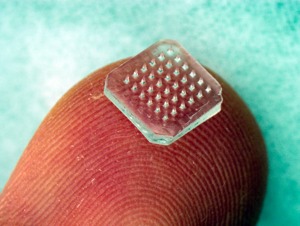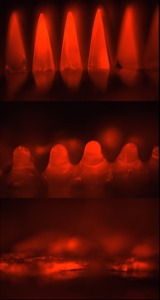
Jeong-Woo Lee, Georgia Tech
Expanding on previous research into the possible use of tiny “micro-needles” to deliver vaccines using a patch, researchers at Emory University and the Georgia Institute of Technology have developed dissolving “micro-needles” made from freeze-dried vaccine that could not only minimize pain associated with vaccinations, but improve immune response, make vaccines more widely accessible and even cut overall vaccination costs — by reducing the number of trained professionals required to administer shots.
To test the efficacy of the newly developed patches — which are about one-third the size of a penny and contain 100 dissolvable micro-needles arranged in rows — researchers conducted a study in mice. They gave one group of mice traditional flu shots, in which the vaccine is injected into the muscle, gave the trial group the vaccine using the patches, and gave a control group no vaccine. Thirty days later, the mice were then exposed to the flu virus. The results, published this week in the journal Nature Medicine show that, while mice in the control group became ill and eventually died, those given the vaccine via patch not only fared as well as those given shots, but that months later the immune response was stronger in mice immunized with the dissolvable micro-needles. When both groups of mice were again exposed to the flu virus three months after initial vaccination, those who had been given the patch had a stronger immune response and were able to clear the virus more quickly.
Researchers say that if additional study confirms the safety and efficacy of micro-needle vaccinations in humans, it could have a dramatic impact on the way that routine vaccinations are carried out — and even help improve access and help reduce needle-related disease transmission in the developing world. If these patches become commonplace, the researchers estimate that the cost would be comparable to that of manufacturing syringe-based vaccines, and considering that individuals wouldn’t need skilled medical workers to administer the vaccines or worry about disposing of harmful sharps after administration — all that’s left is a patch to throw away — it could trim costs overall. As Mark Prausnitz, professor of chemical and biomolecular engineering at Georgia Tech, said in a statement about the findings:
“The dissolving microneedle patch could open up many new doors for immunization programs by eliminating the need for trained personnel to carry out the vaccination… This approach could make a significant impact because it could enable self-administration as well as simplify vaccination programs in schools and assisted living facilities.”


